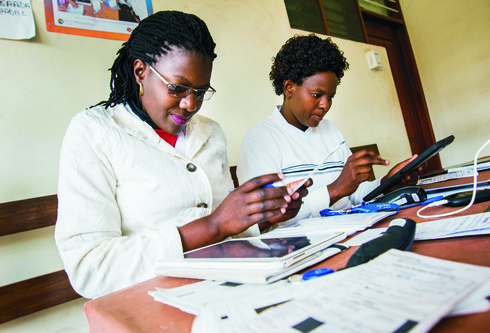As a Design and Innovation Specialist with PATH’s Living Lab, I get to be part of an amazing journey—listening to care providers’ pain points and then working with them to develop simple solutions to help solve those challenges. Here’s a closer look at two of the childhood immunization solutions our team recently co-created with health workers at select facilities in Kenya.
The 7 Star Caregiver & Child card
Among the several solutions we have created, the 7 Star Caregiver & Child card stands out for me. The card is attached to a mother-child booklet, and the seven primary vaccines are demarcated on the card. Each time a child receives a vaccine, a star is added to that vaccine on the card. At 18 months, a child gets their last vaccine—measles 2—and is then considered fully immunized. They receive their last star at this stage and a certificate of appreciation.

The 7 Star Caregiver & Child card showing two stars for two completed immunizations. Photo: PATH.
The card is user-friendly for both literate and illiterate caregivers because one only needs to count the number of stars on the card and see when they are due for the next vaccine. The stars also help track any vaccines the child has missed. An empty star slot lets the caregiver know that the child is not fully immunized and needs to return to the facility on the indicated date.
This solution was adopted at select facilities in December 2021, and now there is a significant demand from caregivers for these cards. The health care providers shared that people visit their facilities to ask if the cards are still available. It makes them feel good that people see their efforts beyond their usual methods to reduce missed immunizations. The solution has reenergized both the provider in service delivery and the caregivers who find it easy to track the vaccine calendar.
Numbered registers
To keep track of immunization data, health care providers use 1,000-page paper registers. Each holds three to five years of immunization data, but these registers did not have page numbers. Whenever a child was taken to a health facility, the health care worker had to flip back through all those 1,000 pages hoping that the child would be identified in less than two minutes or so. This caused a lot of stress at the registration desks, both for the health worker and the caregiver.
To ease the work burden, we added page numbers to the registers. Now, when a child visits a facility, the page number is noted on the mother-child booklet. During their next appointment, a provider references the number on the booklet to locate the child in the 1,000-page register. As a result, the identification time has been reduced to approximately 30 seconds, down from an average of four to five minutes, per child.
At the clinics where they have been implemented, these solutions have helped to improve the quality of service delivery and reduce patient time spent waiting in queues.
From ideation to completed concepts
To create solutions like the 7 Star Caregiver & Child card and numbered registers, the Living Labs team uses a human-centered design approach and the 4Ds methodology: Discover, Define, Dream, and Design.
First, we visit health facilities to engage health care workers directly and Discover their problems, challenges, and successes. Personally, I love the Discover phase. I get to understand their lived experience and ultimately, when designing, I do so based on users’ needs.
Next, we draw insights from everything we document. Every detail is significant. We make sense of all the data we have collected, drawing out themes and patterns to Define the core problem from the health care workers’ perspective.
Then, we go back to the facilities and share with them the problem that we have Defined and ask them if they agree or not. Sometimes, they’ll tell us yes but that there are other challenges as well. In such cases, we dig deeper with them because our processes are cyclical.
In the Dream phase, we co-create solutions with users via workshops and brainstorming on solving the problem. Once they tell us what they think their solutions are, we “spice” up the solutions and later return to the users and explain how they might work in practice.
After that point, we focus on Designing prototypes for the health workers to test. From there, we iterate and refine together until the perfect tool or intervention is reached.
Elevating the voice of the user
Living Labs has allowed me to work with a range of people, from Ministry of Health officials and health care providers to patients, communities, and families. I’m proud that this work is a way to elevate the voices of the providers and of the people they care for, and to center their perceptions, needs, and preferences in designing solutions. It’s essential to properly define the problem—that’s the only way to develop successful solutions.



